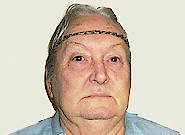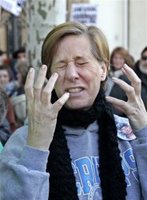Thursday, December 29, 2005
Don't Forget to Set Your Clocks Back
¡Feliz Año Nuevo!
Evo, What a Dunce
Evo Morales fue víctima de otra broma: esta vez quisieron casarlo
En el Día de la Inocentes, un diario boliviano bromeó con el supuesto casamiento del presidente electo. La semana pasada había vivido otra escandalosa situación con una radio española
Un diario boliviano anunció la futura boda del presidente electo Evo Morales con una joven concejal de su partido, miembro de la burguesía de Santa Cruz, una de las zonas más ricas del país.
En el Día de los Inocentes, el diario "El Deber" bromeó con el supuesto casamiento del líder cocalero. En la sección sociales tituló: "Evo Morales se casa con Adriana Gil el sábado 31". El matutino calificó a la noticia como una "bromaza".
Hace algunos días, Morales, de 46 años y soltero, dijo que la primera dama, cuando asuma el 22 de enero, será... Bolivia.
La semana pasada, Evo sufrió, en persona, otra broma, pero esa vez por parte de los españoles. Y no fue en alusión al Día de los Inocentes. Una radio de la Iglesia Católica le hizo creer que habló telefónicamente con el presidente Rodríguez Zapatero.
La humorada terminó en un escándalo político y religioso. El gobierno español exigió a las autoridades eclesiásticas una disculpa. Ahora Zapatero lo invitó a visitar España antes de la asunción.
Wednesday, December 28, 2005
El Santo de Los Idiotas
An Icon of Evil
Commentary
By WILLIAM MEYERS
December 27, 2005
Cuba is a communist country. This will not be news to the readers of The New York Sun, but it may come as a surprise to visitors at the International Center of Photography. In the almost 400 words that make up the wall text at the entrance to "Che! Revolution and Commerce" and discuss its eponymous hero, neither "communist" nor "communism" appear. It is like explaining who Osama bin Laden is without mentioning he is Muslim.
The first paragraph of the wall text informs the visitor that the exhibition is about "Alberto Korda's 1960 portrait of Ernesto 'Che' Guevara, titled 'Guerrillero Heroico,'" and that for "the last 45 years, this iconic photograph has symbolized antiestablishment thought and action." That's true enough, and for an institution that prides itself on its willingness to deal with the "transgressive," a mighty plus.
It points out approvingly that the picture was used during the 1968 student uprisings in Europe. These, however, were revolution as opera bouffe. Che's picture was certainly not displayed during the Solidarity protests in Poland in the 1980s or in the Tiananmen Square demonstration in China in 1989, when men and women genuinely hazarded their lives for freedom.
Ernesto "Che" Guevara was a sociopathic thug, a man who genuinely relished killing, a man with a passion for putting his pistol to other men's heads and blowing their brains out, preferably when they were bound, gagged, and blindfolded. Oh, and there is no record of the heroic guerrilla of "Guerrillero Heroico" actually having prevailed in real-life guerrilla battles of any consequence, and very little of his participating much in combat of any sort.
Fidel Castro, his brother Raoul, and Che were able to steer the Cuban revolution away from democracy through backroom politics, the use of fear and propaganda, and the imprisonment of genuine democratic leaders, like Huber Matos and Mario Chanes De Armas. What makes Guevara interesting is that in everything he did he was a total bungler, the Inspector Clouseau of revolution. This, too, seems to have escaped ICP's attention.
The first sentence of the second paragraph of the wall text informs the visitor that Korda's picture was taken "on March 5, 1960, at a time when Che held a position in the Cuban government overseeing the country's transformation from an agrarian to an industrial economy." Where to start with this?
In 1959 when the dictatorship of Fulgencio Batista was overthrown, Cuba had one of the highest GDPs of any country in Latin America. Within months of Castro's appointment of Guevara as minister of economics, the Cuban peso, which traditionally was equal to a U.S. dollar, was virtually worthless, and so it remains. The next year, 1961, Guevara became minister of industries, and the island's factories either closed or began their steady decay. The Cubans who have prospered since the revolution are either party officials or those who made new lives for themselves in exile.
The one job Guevara excelled at was when he was commander of La Cabana prison, Havana's equivalent of Moscow's notorious Lubyanka. He liked overseeing executions and personally administering the coup de grace. Pierre San Martin, an inmate of La Cabana who made it out alive, gave the tenor of Guevara's administration in an article published in El Nuevo Herald from December 28, 1997.
A 14-year-old boy, badly beat up, was brought to the prison. When those in his cell asked why he was there, he explained that he had tried to protect his father, who was being taken to the firing squad. Che's guards soon returned and led the boy from the cell. "Then we spotted him, strutting around the blood-drenched execution yard with his hands on his waist and barking orders - Che Guevara himself," Mr. San Martin recalled.
"'Kneel down!' Che barked at the boy.
"'Assassins!' we screamed from our window.
"'I said: KNEEL DOWN!' Che barked again.
"The boy stared Che resolutely in the face. 'If you're going to kill me,' he yelled, 'you'll have to do it while I'm standing! Men die standing!' "Then we saw Che unholstering his pistol. He put the barrel to the back of the boy's neck and blasted. The shot almost decapitated the young boy." And so it goes. ICP tells us, "Che left Cuba in 1965 with the goal of inciting revolution in the Congo and then in Bolivia," but not that those incitements were comic examples of bumbling incompetence, funny except for the dead left behind. You can look it up. The wall text refers to Guevara's "classical, even Christ-like demeanor," it says his "enigmatic gaze encompasses both determination and desire," and that he "was a young and charismatic idealist who gave up the security of his middle class world for his convictions." And Hitler was a vegetarian who became an important European statesman. Cornell Capa founded ICP in 1966 as the International Fund for Concerned Photography, and it has always had a social mission. Not surprisingly, its political cast is leftish. Soon after the American invasion of Afghanistan, it displayed pictures of civilian casualties with an accompanying wall text that explained war was bad. When the pictures from Abu Ghraib became available, it immediately devoted a room to an exhibition titled "Inconvenient Evidence" and quoted some of Susan Sontag's inanities. It is right that ICP should remind us of our responsibilities to innocent civilians caught in the way of battle, and even that it should be solicitous of the welfare of terrorists, but why is it indifferent to the suffering of the Cuban people over the last half century, to the poets, artists, and homosexuals who have been murdered or imprisoned, who are in prison now? Why should a major cultural institution gull its public? Or is it just inexcusably ignorant? The examination of the uses to which one particular picture - an icon - can be put is certainly a project within the purview of the International Center of Photography's mission. Had it begun "Che! Revolution and Commerce" by explaining to the public what sort of man Ernesto Guevara was, it might have been a valuable exhibition. How successful it is, I cannot tell you. I went to the press preview, but was so affronted by the despicable wall text at the entrance, I turned around and walked out.
Tuesday, December 27, 2005
Best Bakery

Esta torta de frutas confeccionada por la panadería más famosa de Los Angeles, California...Portos. Está úbicada en Glendale, y por supuesto es cubana. Another delicious desert enjoyed by everyone at the Nochebuena family gathering.
Monday, December 26, 2005
Palabra cubana del día - A dieta
English: On a diet
Cuban: Without sexual contact - sin contacto sexual. "es que estoy a dieta hace doce meses, desde que me dejó mi mujer".
Sunday, December 18, 2005
Sheehan Leads War Protest in Spain
Saturday, December 17, 2005
La Leyenda Hecha Historia
Encontré la siguiente interesente información en la página de la periodista Maria Elvira Salazar en www.mariaelvira.com
-----------------------------------------------
Dice la leyenda, hoy hecha historia, que la Virgen de la Caridad se le apareció a SAN ANTONIO MARÍA CLARET – una vez más – y le predijo, textualmente, lo siguiente:
“A esta Sierra Maestra (Claret fungía como arzobispo de Santiago de Cuba, capital de Oriente, donde se encuentra la famosa Sierra Maestra) vendrá un joven de la Ciudad y pasará un corto tiempo cometiendo hechos muy lejanos a los mandamientos de Cristo. Habrá inquietud, desolación y sangre. Vestirá uniforme no tradicional, jamás visto en el país. Muchos de sus seguidores llevarán rosarios y crucifijos colgados al cuello e imágenes de muchos santos junto a armas y municiones. Este joven bajará de las estribaciones de la Sierra Maestra con barba y muchas veces fumando un puro. Será recibido con fervor por el pueblo cubano, al cual engañará, lo dividirá y lo dejará sumido en angustias con mucho dolor y sangre.”
“La República será entregada a un hombre que viene de un país muy lejano, que hablará un lenguaje que no es ni castizo ni romano. Con la riqueza de la isla, Cuba entregará la soberanía y la independencia que hoy se añora (se refería al fervor patriota e independentista que se sentía en la atmósfera cubana de la década de los cincuenta, que precedió al “Grito de Yara”). Todo los cubanos serán presos y esclavos de un sistema maléfico.”
“Este joven gobernará por casi CUATRO DÉCADAS… cercano al medio siglo. En ese tiempo habrá sangre, mucha sangre. El país quedará desvastado. Cuando se cumpla ese tiempo, ese joven que ya será un viejo, caerá muerto y entonces el cielo cubano se tornará limpio y azul, sin esta oscuridad que ahora me rodea.”
“Se levantarán columnas de polvo y otra vez la sangre anegará el suelo cubano por unos pocos días, sin embargo, como dice el refrán
“Habrá un gran movimiento de barcos en las aguas que de lejos las grandes bahías de Cuba parecerán ciudades enclavadas en el mar. Habrá venganzas y revanchas entre grupos dolidos y otros codiciosos que – por corto tiempo – empañarán de lágrimas los ojos.”
“Después de estos días tormentosos, lo mejor para Cuba estará por venir. Se erradicarán enfermedades, vendrá el arrepentimiento, se extinguirán falsas religiones y la fe cristiana entrará en los corazones ateos.”
“Después de toda esta catástrofe que ahora veo, saldrá el arco iris anunciando la paz y la prosperidad para todos los cubanos. Cuba será la admiración de toda América, incluyendo la del Norte.”
Friday, December 16, 2005
700 Mile Fence Along US/Mexico Border
Thursday, December 15, 2005
Will Jesse show up?
 Another murderer headed for lethal injection in California. Clarence Ray Allen, 75 years old has been in death row for over 23 years for the murder of 3 persons. Clarence has asked Gov. Arnold Schwarzenegger for clemency, due to his failing health. Clarence is tied to a wheel chair, has diabetes, and he is going blind. I am sure that the medications are not costing the taxpayer much!
Another murderer headed for lethal injection in California. Clarence Ray Allen, 75 years old has been in death row for over 23 years for the murder of 3 persons. Clarence has asked Gov. Arnold Schwarzenegger for clemency, due to his failing health. Clarence is tied to a wheel chair, has diabetes, and he is going blind. I am sure that the medications are not costing the taxpayer much!Here is an interesting chart from the US Department of Justice:



